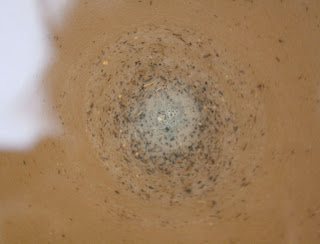Oklahoma Red Dirt detail, 2010.
I first saw the process of extracting usable pigment from dirt for painting on cloth in a workshop with John Marshall at Earth’s Palette Natural Color Conference in 2009. John Marshall is king of pigment painting processes for textile artists. He is an extraordinary artist. Please visit his website where you will find a gallery of natural pigment works and extensive “how to” information about painting with pigments and soy milk.
The process of washing dirt is both literal and symbolic. Since the workshop one of my mantras has been “Wash Your Dirt”. The saying “Don’t hang out your dirty laundry” had already been rolling around in my head. I had been in a personal process of washing my own dirt. All of us need clearing out from time to time and this happened to be the year for me.
Needless to say, I take this process to heart and I finally experimented, washing good ‘ol Oklahoma Red Dirt! The instructions are pretty basic, although the first time I did it I poured off all the good pigment liquid. * I find a photo essay of the process helpful.
The process of extracting pigments from soil has a long history. There are quarries in the Appalachian region of the United States, in France, and other countries that commercially extract and wash dirt to obtain the natural colorants. As I learn more about these histories I will this information.
*Note: Washing Oklahoma Red Dirt was originally posted 13 May and edited 15 May. There is nothing like waking up at 4 am the day before packing for a week long canoe trip and realizing that the instructions I posted for washing dirt was not specific about reserving the top 3/4 liquid during the washing process! Please see corrections, comments are always appreciated.
Basic “literal” dirt washing concept (adapted from John Marshall’s instructions):
*Note: Washing Oklahoma Red Dirt was originally posted 13 May and edited 15 May. There is nothing like waking up at 4 am the day before packing for a week long canoe trip and realizing that the instructions I posted for washing dirt was not specific about reserving the top 3/4 liquid during the washing process! Please see corrections, comments are always appreciated.
Basic “literal” dirt washing concept (adapted from John Marshall’s instructions):
1. Fill a 5 gallon plastic (preferably white because it is the most reflective) with your local dirt. This dirt may have debris of sorts which will be removed throughout the washing process.
Washing Dirt, step 1, 2010.
2. Add water, making a muddy mixture. John Marshall describes this step as a “muddy slurry”. Stir the mixture really well; it takes some muscle to get the momentum going. I found using a fat dowel stick to be a substantial stir stick.
Washing Dirt, step 2, 2010.
3. Let stand until the water stops swirling. Pour off the top 3/4 of this mixture and RESERVE IT.
Washing Dirt, step 3, 2010.
Sludge leftover after first "pour off", 2010.
First "pour off" up close, 2010.
Slurry residue detail, 2010.
4. Repeat this process, RESERVING THE TOP 3/4 LIQUID EACH TIME. I did it 5 times for this experiment but it will depend on your local dirt. The idea is to remove all the heavy stuff, like sand, which will settle to the bottom. Debris such as foreign objects, dried leaves, whatever you find when you start digging, will be removed in the process.
Washing Dirt, step 4, 2010.
Leftover after third "pour off", 2010.
5. I ended up using a strainer to catch the medium particles that were being stubborn. Each time the bucket is filled with water, stir it well, let it stop swirling and pour off the top 3/4 of liquid and RESERVE THE LIQUID.
Washing Dirt, step 5, 2010.
Swirling Dirt with Debris, 2010.
Leftover after Fourth "pour off", 2010.
Fourth "pour off" leftover,
detail, 2010.
6. Once the water appears relatively clear, let the mixture rest. During the resting period the remaining sediment will settle. The sediment on the bottom will be the extracted pigment. I placed some of this liquid in a glass jar so I could see the pigment settle.
Washing Dirt, step 6, 2010.
Washing Dirt, resting detail, 2010.
7. The mixture should rest overnight or about 24 hours.
8. Decanting is a common process when working with natural materials. The liquid is poured off and either reserved or discarded relative to the process of extraction: brewing liquors, making wine, extracting color from a natural material. There are times when the decanted liquid is the desired product, like the rose petal liquor I am making; rose petals and brandy are macerated together, after six weeks I will decant the brandy, discarding the rose petals.
Washing dirt reserves and discards or decant the liquid during the final stage. The liquid will be gently extracted from the settled pigment and the liquid will be discarded. Then, the sediment or pigment will be left to dry.
Washing dirt reserves and discards or decant the liquid during the final stage. The liquid will be gently extracted from the settled pigment and the liquid will be discarded. Then, the sediment or pigment will be left to dry.
Washing Dirt, step 8, 2010.
Washing Dirt, step 9, 2010.
9. Once thoroughly dry, peel away or break up the surface of the dried sediment. It will be flaky. Because I let my Oklahoma Red Dirt dry in a plastic bucket it peeled like paint off the bottom. When I use it for pigment painting I will grind it with a mortar and pestle.
Dry Oklahoma Red Dirt Pigment,
step 9 detail, 2010.























those flakes of dirt pigment look delectable...if you're not squeamish, try mixing the ground stuff with a bit of saliva [i do it in the palm of my hand]. sticks to paper and cloth a lot better than soy...
ReplyDelete